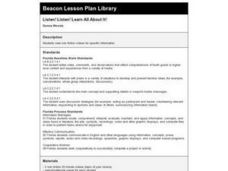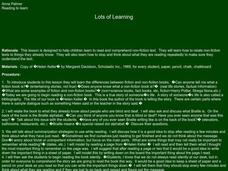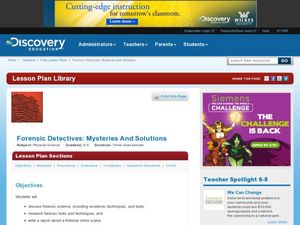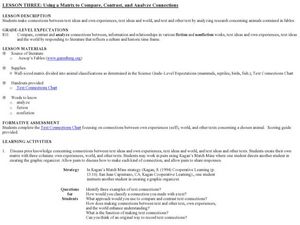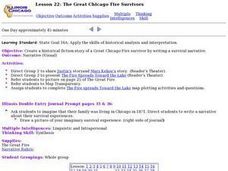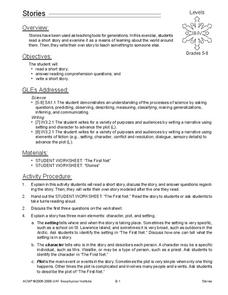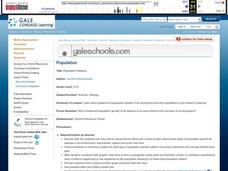Science NetLinks
Green Roof Design
Green roofs aren't just eco-friendly — they are literally green with trees. Groups learn about the concept of green roofs in order to be able to design one. The groups design a 5,000-square-foot green roof for a fictional apartment row...
Curated OER
Discovering the Deep
Students explore the world's oceans. They research questions about the oceans and write a research report about an ocean animal. Students identify at least four different writing genres they experienced while reading about the ocean.
Curated OER
Listen! Listen! Learn All About It!
Fourth graders view non-fiction videos. They write questions that can be answered with information in the video. Every 10 minutes the video is stopped and the class discusses the questions.
Curated OER
Coral Reefs
Students examine the animals that live in a coral reef and how they adapt to their environment. In this coral lesson students write a short book on how animals inhabit the coral reefs.
Curated OER
Reading to Learn
Children learn to read and comprehend non-fiction text and explore how to relate non-fiction texts to things they already know. They then examine how to stop and think about what they are reading repeatedly to make sure they understand...
Curated OER
Under The Sea
In this resource lesson, students use non-fiction books to research ocean animals. Students discover the many features of non-fiction books and how to use these features to help them conduct research. Students then categorize ocean...
Curated OER
Do Fish Clean the Ocean?
Pupils analyze a reading selection. In this ocean lesson, students read a story about the ocean, ocean animals and coral reefs. Pupils have the option to complete internet research on coral reefs. Students write in their journals...
Curated OER
Reading Research!
Young scholars observe the pictures in non-fiction books that focus on animals in the winter. In addition, they also listed to some read aloud books about hibernation, migration, adaptation and dormancy. Students draw pictures and write...
Curated OER
Jack and the Beanstalk
Third graders examine a reading selection. In this fairy tale lesson, 3rd graders read Jack and the Beanstalk. Students are divided into groups and each group lists the elements of a fairy tale and writes a script for a puppet play of...
Curated OER
Summarize This!
Students explore how to summarize a reading passage. They read non-fiction books. Students use a Venn Diagram to compare and contrast the two animals they read about. They write a summary using the information in their Venn Diagram.
Curated OER
Forensic Detectives: Mysteries and Solutions
Students examine forensic science. In this video based instructional activity, students examine the tools and techniques of forensic science. They write a report about a fictional crime scene from the Discovery video.
Alabama Learning Exchange
Weather Instruments For Sale
Students create advertisements for a weather instrument. They conduct Internet research, write a descriptive and persuasive advertisement for the instrument using the flyer template of desktop publishing software, and print a copy that...
Curated OER
Cricket Times
Students design a class newspaper all about their study of crickets, including illustrations and various sections of the newspaper, like sports, jokes, articles, food, and reviews. Students create a plan to design a cricket from food...
Curated OER
Using a Matrix to Compare, Contrast, and Analyze Connections
Students explore writing techniques by comparing fiction vs. non-fiction. In this literature analysis lesson, students read stories from Aesop's Fables and compare the themes and characters to stories from their own life. Students...
Curated OER
Rainforest Introduction
First graders explore world geography by completing a KWL chart. In this rainforest research lesson, 1st graders read a fictional story discussing a boy who lives in the rainforest. Students analyze the story, identify the plot and...
Curated OER
Clustering
Fifth graders are introduced to the concept of clustering. In groups, they use their new science vocabulary words to put into a web or cluster. To end the lesson, they read a book related to electricity and write the definitions of any...
Curated OER
Lesson 22: The Great Chicago Fire Survivors
Students, in groups, create a historical fiction story of a Great Chicago Fire survivor by writing a survival narrative.
Curated OER
Reindeer Research
Students research reindeer habitats and purposes. They investigate the historical significance of reindeer and the Christmas holiday. Finally, they write a short fictional story about reindeer using the information from their research.
Curated OER
Who Are We? An Introduction to the Life Within Our Bodies
Students examine cell structure, cell division, and the basic structure of DNA. They read and discuss a case study of DNA research, answer discussion questions, role-play the process of mitosis, and complete a DNA Fact or Fiction worksheet.
Curated OER
Weather the Storm
Fourth graders complete multi-curricular activities for weather. In this weather lesson, 4th graders complete creative writing, research, and weather data analysis activities for the lesson.
Curated OER
Wood
Students practice reading comprehension strategies. In this literacy and science lesson plan, students read a non-fiction article about wood and locate main ideas and details. Students construct a card game using information taken from...
Curated OER
CSAP Preparation: "Strike While the Iron is Hot"
Students survey several concepts in literature, science, history, and geography as a preparation for the CSAP standardized testing experience. This nine lesson unit provides exposure to the format and content of the test.
Curated OER
Stories
Students read and write a short story. In this short story lesson plan, students read a short story and answer comprehension questions on it that teaches them about the world around them. Then they write a short story to teach something...
Curated OER
Population Patterns
Students study patterns of population growth in an ecosystem and why populations must remain in balance. They interpret basic population graphs and suggest scenarios about different population growth patterns in an ecosystem.




